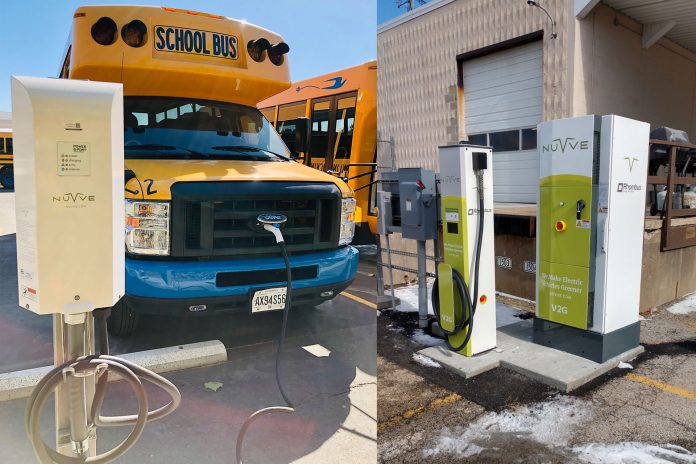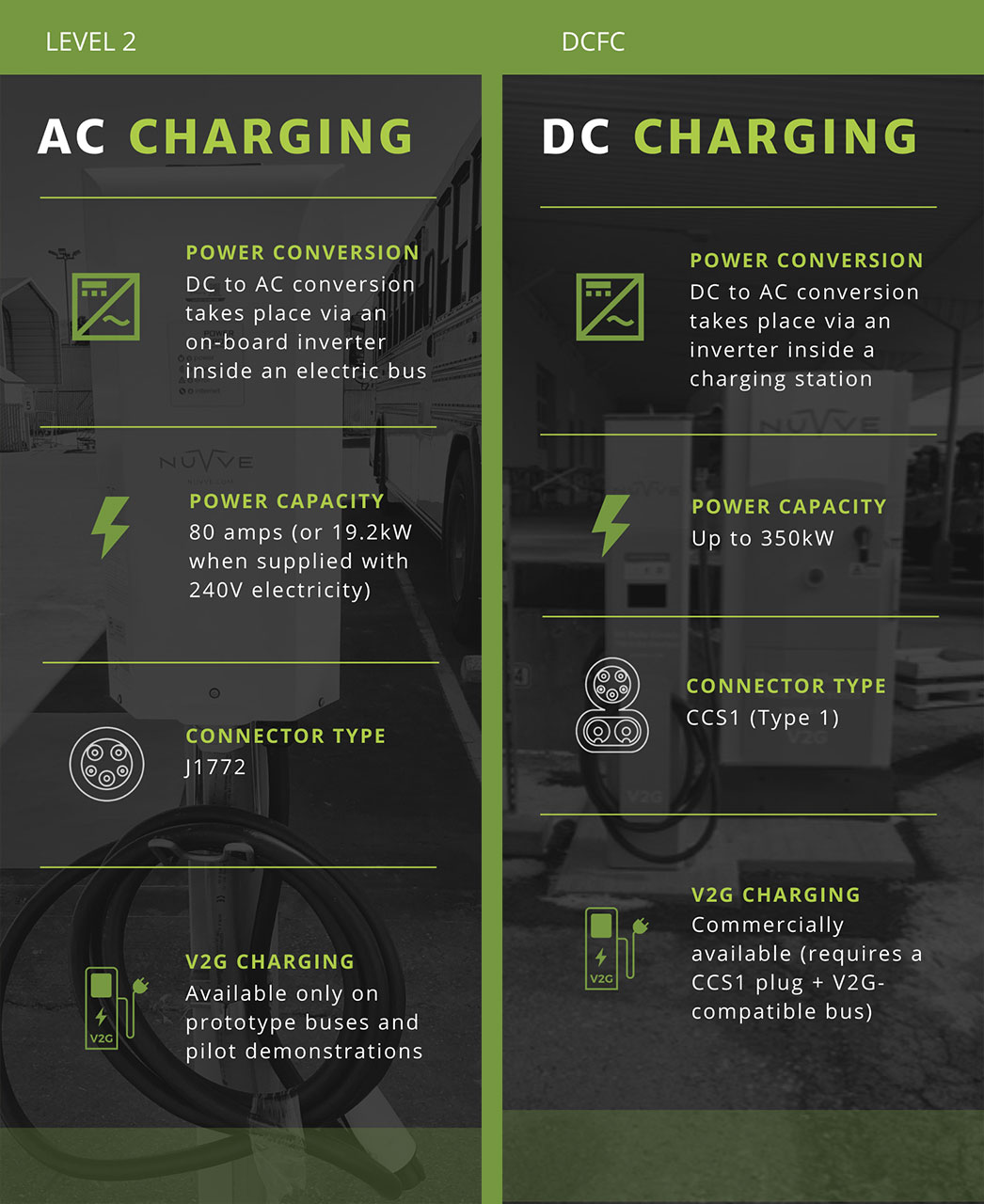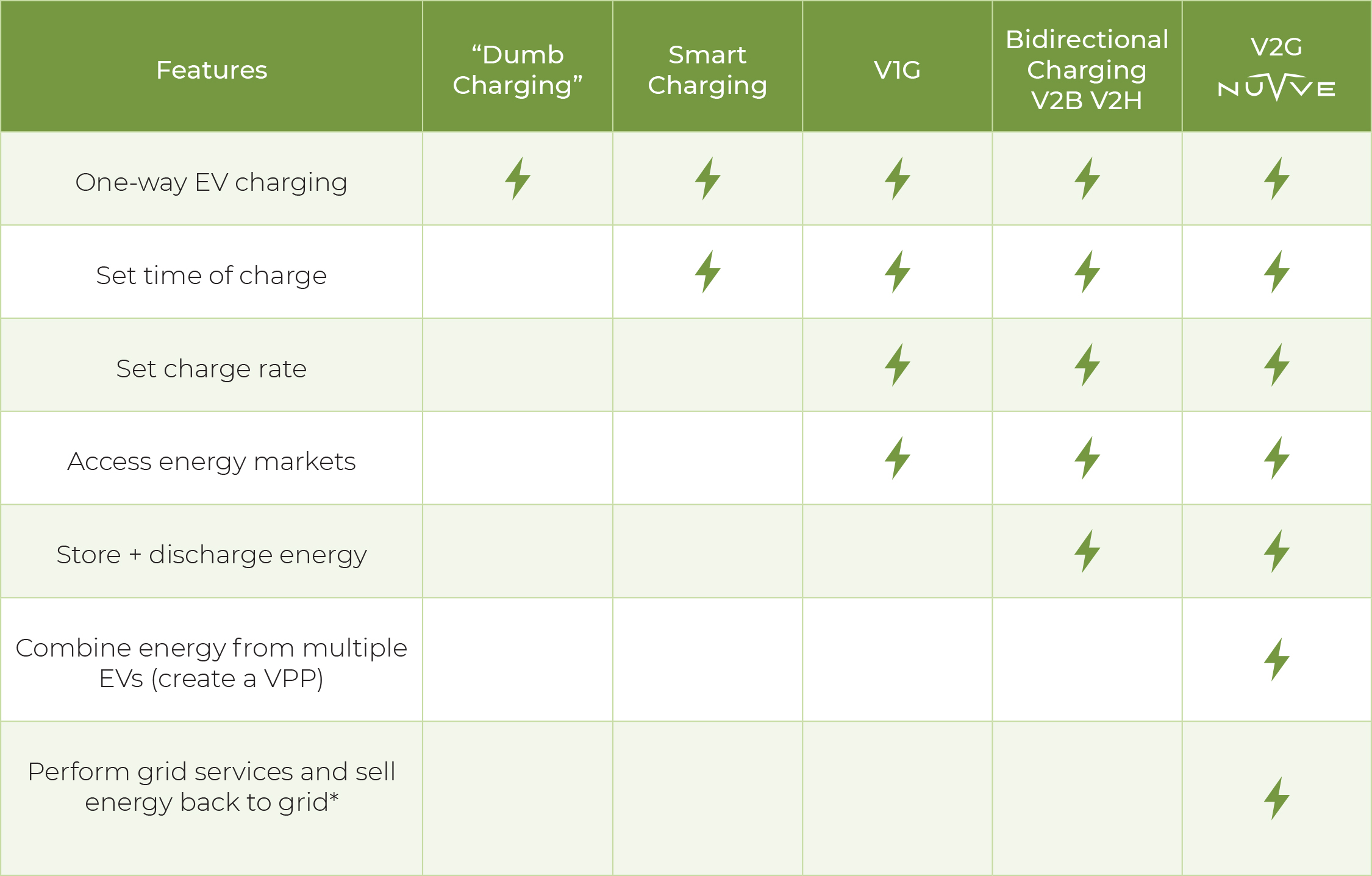When it comes to electrifying your school buses, there is a lot of new information to navigate. We recently explained the different types of charging or energy services which clarifies the advantages of technology like vehicle-to-grid (V2G), but there are also important differences when it comes to charging stations or EVSEs (electric vehicle supply equipment).
Here’s a breakdown of some of those differences and why they’re important for school bus operators.
AC vs DC
AC stands for “alternating current.” AC is the type of power that goes in and out of the electric grid we all plug into. DC stands for “direct current” and is the type of power we get from batteries like standard AA batteries you use for personal electronic devices.
Electric bus batteries can only store power as DC, which means a conversion needs to take place to enable different levels of charging.
In both AC and DC charging, an inverter is required for power conversion, but where the inverter lives differs – it is either inside the bus (AC) or inside the charger (DC).
How AC power conversion works:

How DC power conversion works:

Side by Side Comparison
For quick reference, here are some differences between AC and DC charging.
Tips for AC Charging
1. Make sure you have the right power level
For example, you need an 80 amp charging station if your electric bus needs 19.2kW
2. Choose a smart charging option
Choose an AC charging solution that goes beyond “dumb charging” and allows you to charge when rates are low to save on utility bills.
3. If you are looking at V2G, consider a DC option
V2G with AC charging is possible but uncommon; confirm your electric buses are V2G-enabled with a bidirectional onboard charger
Tips for DC Charging
1. Not all DC charging is “fast”
The term “DCFC” (DC Fast Charger) refers to a range of different power levels depending on the charging station provider.
To make sure your DC station is really “fast charging,” you can do some simple math: electric bus battery size (kWh)/charging station size (kW) = charge time.
For example, a DC charger with a capacity of 25kW will take over 6 hours to fully charge a bus with a 155 kWh battery; a DC charger with a capacity of 60kW will take less than 3 hours to charge a bus with a 155 kWh battery
2. Check the DC charging station specs
For DC charging, you need to have the correct voltage output, so check the compatibility between the electric bus and charging station.
For example, if you have an electric bus with an 800V DC battery pack but your charging station has a maximum voltage output of 400V, you won’t be able to properly charge your bus.
3. Take advantage of V2G with DC charging
Due to utility interconnection requirements, DC charging is preferred for V2G operations.
Make sure your DC charger has a CCS1 connector and your bus is V2G-enabled.
V2G Charging with DC
V2G has many cost savings benefits in addition to opportunities to generate revenue through grid services and selling energy back to the grid, where utilities allow this. To take full advantage of V2G benefits, you will need a V2G-capable DC charger, V2G-enabled electric bus with a bidirectional onboard charger, and a V2G software platform integrated with both.
Here’s a recap of the differences between V1G, bidirectional, and V2G charging.
Nuvve’s EVSE Options
Nuvve offers both Level 2 AC and DCFC options optimized for electric school bus charging. Our DCFC 60kW and 125kW charging stations are preconfigured with our proprietary V2G software that helps maximize savings and creates revenue generating opportunities (where applicable).
But don’t worry – you don’t have to memorize these details. Nuvve’s team of experts can help guide you the electrification process to create a custom solution for your school bus operation.
We also offer flexible financing options including full financing and no upfront costs, so you don’t have to wait for grants or funding to go green.
See answers to frequently asked questions below.
To learn more, visit nuvve.com/stn or email us at evse@nuvve.com.
FAQ
- Can any electric bus perform V2G services?
No, the electric bus needs to be V2G-capable, use a CCS1 connector plug, and have technology integrations that allow bidirectional energy flow.
- Can I do V2G with an AC charger?
While AC charging can be V2G capable, in the U.S., electric buses cannot use AC charging for full V2G bidirectional charging due to the nature of the onboard inverter.
- How is Nuvve doing V2G with a CCS1 plug?
Nuvve developed and deployed a custom integration with select bus manufacturers that enables the bidirectional flow of energy between an electric bus and DC charging station using this type of connector.
- What electric school buses are V2G-compatible?
Today, Nuvve has software platform integrations with several electric bus makers; contact us to learn more.
- What’s the difference between bidirectional charging and V2G?
Bidirectional charging allows you to charge and discharge energy from an electric bus battery; V2G is a more sophisticated level of control that enables grid services and energy market participation. See the matrix above for reference.
- What is the difference between DC fast charger with V2G versus a DCFC that is non V2G?
A DC fast charger with V2G will help you save money in a more efficient, effective way through the precise control of energy flow in and out of a bus’ battery and to the electric grid. Besides charging when rates are low, in certain areas, V2G allows electric buses to earn revenue by selling extra energy from bus batteries back to the grid.
- Do Nuvve’s DC fast chargers only work with V2G-compatible buses?
No, we can charge any vehicle that accepts DC fast charging, even if the vehicle is not V2G-capable.
- How do I decide what electric bus-charging solution to buy based on my routes?
Evaluate your bus routes to determine if you will have sufficient time to charge with a Level 2 versus DCFC charger.
If you plan on growing your fleet, consider future-proofing your charging infrastructure. Bus battery capacities keep improving so your charging station power needs to keep up.
Choose a charging station that goes beyond “dumb charging” and allows flexibility on scheduling charge times to save on utility costs and more.


















